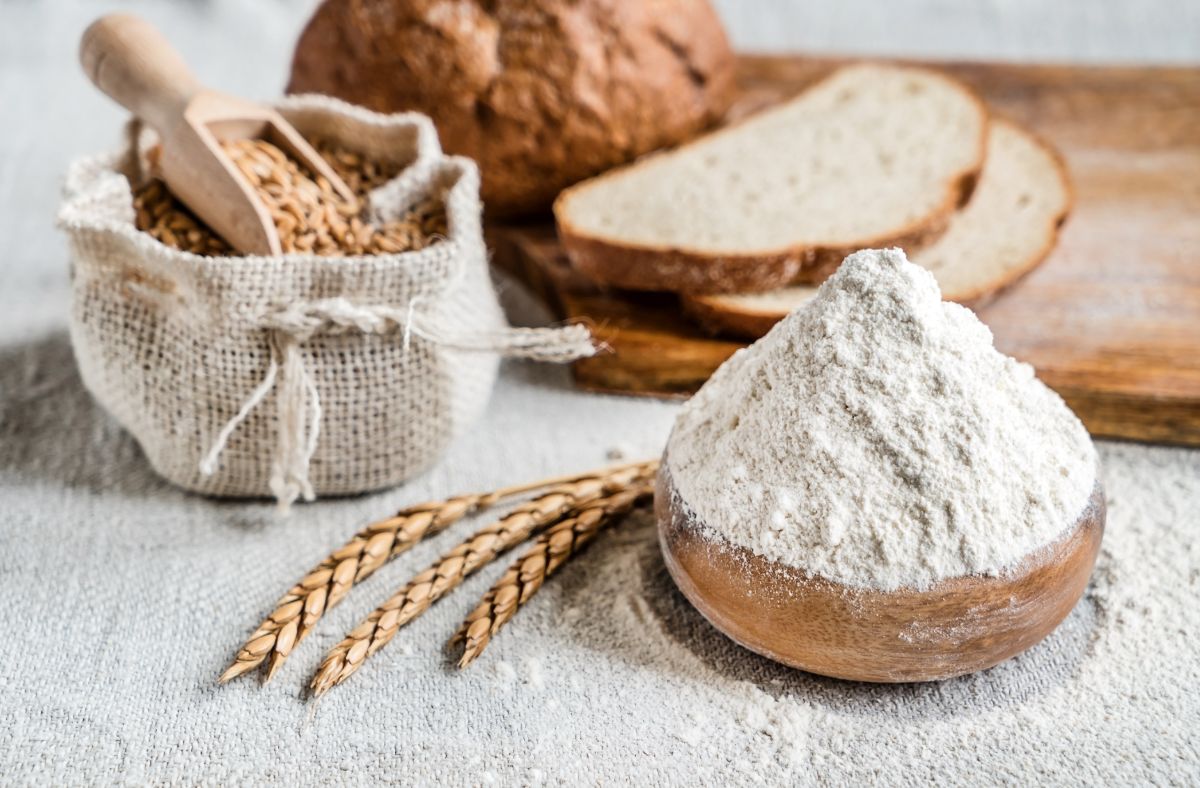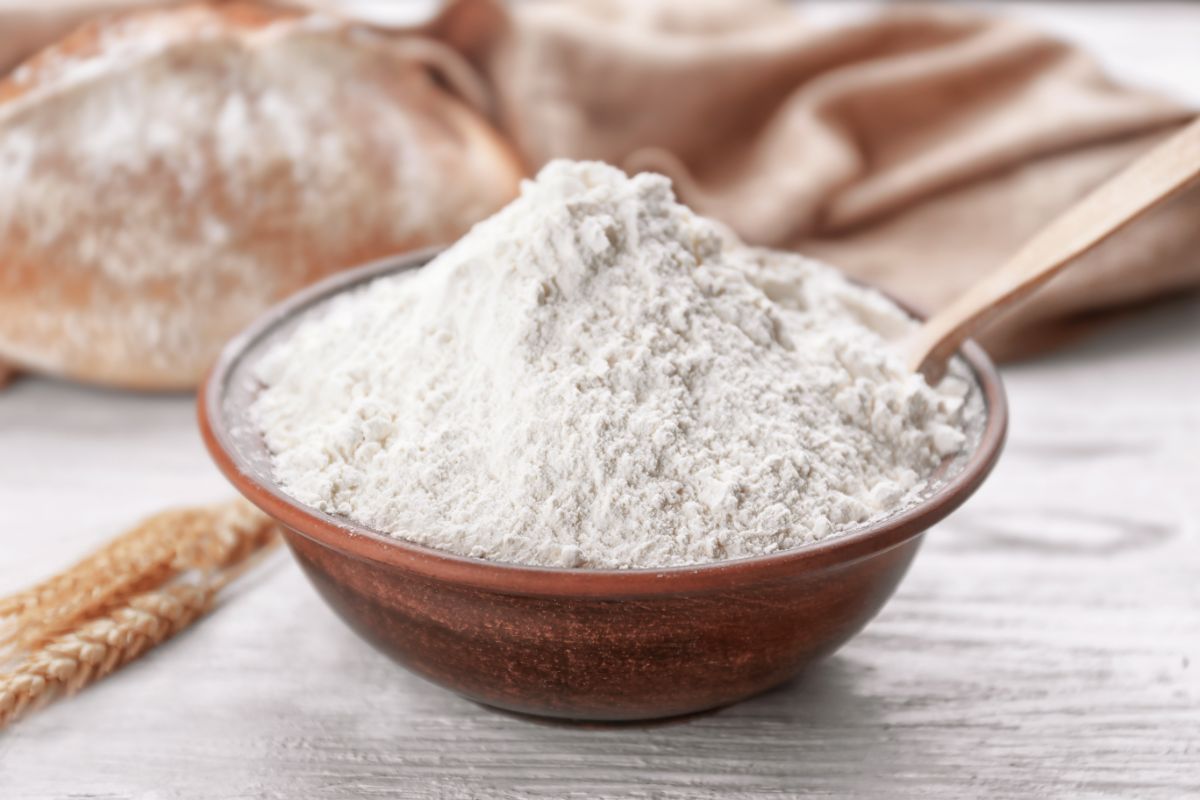The simple answer is that it exists to make bread. However, that doesn’t tell you why you can’t use cake flour to make bread or why all-purpose flour may not make great bread.

The main purpose of bread flour is to provide that support structure to make the thick, airy interior we associate with loaves of bread.
How does bread flour differ from other types of flour?
Bread flour has far more protein and gluten than other types of flour. The gluten makes the dough elastic. It can rise much further than cake flour.
The stronger bonds also allow it to expand and retain its shape.
Gluten consists of two main proteins.
The glutenin gives it elasticity. The gliadin causes it to resist stretching. The two together plus water create the structure within the dough that allow you to shape it and hold it in shape when you aren’t kneading it.
Can you make bread with all-purpose flour?
Yes, you can. The all-purpose flour has about ten percent less protein (9 to 11 percent versus 10 to 15 percent). This means bread made with all-purpose flour is more likely to “mushroom” or overflow the container.
Think of it as your loaf of bread having a fair muffin top. Yet there won’t be much difference in its consistency. In fact, all purpose flour tends to make the fluffier bread we associated with sandwich bread.
There’s another reason you may not want to use all-purpose flour. It is typically bleached and processed. It has fewer nutrients, though others like iron may be added to it to offset the lost proteins.
If you’re making bread, use unbleached all-purpose flour instead of bleached flour. Save the bleached flour for cakes and pastries.
How do you add gluten to flour?
If you’re left with all-purpose or cake flour and want to make bread, you can create substitute bread flour by adding gluten to it. The vital wheat gluten will be called gluten or pure protein.

You’ll only need to add a few spoonfuls of gluten at most. Fail to do this with all-purpose flour that calls specifically for bread flour, and the bread will not rise as much as expected and be much crumblier.
Alternatively, you can use a bread recipe that calls for all-purpose flour and substitute different ratios of eggs, water and yeast to get the right consistency.
Another tactic is to autolyze the bread. With this technique, you hydrate the dry ingredients and then let it sit for about twenty minutes.
The gluten in the dry ingredients has more time to “knit” itself and build the bonds that hold the bread together. After this twenty minute (or longer) period, you can start kneading the bread and following the rest of the recipe.
You can add some wheat germ to bread in place of flour, though it is not flour. You can replace up to a third of the flour in a recipe with wheat germ.
You’d want to have at least one cup of wheat flour of some kind with every cup of non-wheat flour so you don’t get a flat loaf so that you have at least some gluten in it.
Why is all-purpose flour so common?
All-purpose flour or AP flour is the most commonly used flour because it can be used for almost anything. You can use it to bake a cake or make bread.
It can be used to make pastries or pancakes. You can use all-purpose flour to make cakes if you substitute one cup of AP flour minus two tablespoons for every cup of cake flour. (Less flour makes up for the higher protein.)
Yet you’ll get a better result when you use the ideal kind of flour for that application.
Can you use bread flour in non-bread recipes?
It is rare for a recipe to call for bread flour in a non-bread recipe. You’ll see the recipe calling for bread flour in crusty bread products like baguettes.
If it gets shaped on a pizza stone or solid oven deck, then bread flour is the right choice. However, you can use bread flour in recipes that call for all-purpose flour.
Note that the extra protein needs to be offset by extra water.
Bread flour is sometimes used in place of some of the whole grain flour in a recipe to give the loaf more gluten. Then you get a fluffier loaf with some whole grains in it than the thick, low-rising bread we typically get with whole grains.
This occurs because whole wheat flour has as much as 16 percent gluten, but the ground-up hulls in the whole grain flour interfere with the gluten strands.
Then they’re less able to support the loaf as it tries to rise. If you have whole wheat flour and want to substitute it for all-purpose flour, you’d use a cup of whole wheat flour minus two tablespoons of AP flour in the recipe.
Note that the end product will still have more fiber than if you used bread or all-purpose flour.
Bread flour is fine if you’re making bread products that are not required to rise like flatbread or crackers.
However, if you want to make quick bread or pastries, the strong, tough gluten ties in bread flour make it hard to get an end product that melts in your mouth.
When you want it to crumble in your mouth like cake, gluten is your enemy.
Do bread recipes change much based on the type of flour you use?
Bread is essentially water, flour, and yeast. As long as you’re using wheat flour, the main ingredient ratios don’t change. The only exception here is cake flour.
Cake flour can have as little as 6 percent gluten. All-purpose flour has around 10 percent gluten. That light, sweet taste of cake won’t translate into much of a loaf of bread.
You could use cake flour if you added extra gluten, but most of us don’t have that around the house. Conversely, you can add gluten to existing all-purpose or bread flour to increase the protein content, and it won’t affect the consistency much.
